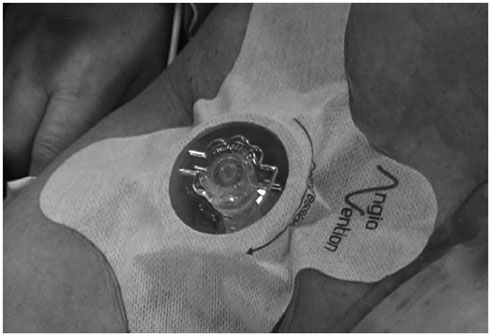J Korean Soc Radiol.
2015 May;72(5):329-334. 10.3348/jksr.2015.72.5.329.
Hemostatic Efficacy and Safety of a Novel Mechanical Compression Device for Femoral Arteriotomy
- Affiliations
-
- 1Department of Radiology, Pusan National University Hospital, Pusan National University School of Medicine, Busan, Korea. radkim@nate.com
- KMID: 1793889
- DOI: http://doi.org/10.3348/jksr.2015.72.5.329
Abstract
- PURPOSE
To evaluate the hemostatic efficacy and safety of a novel mechanical compression device for femoral arteriotomy.
MATERIALS AND METHODS
We identified 290 patients who underwent vascular intervention with a novel mechanical compression device applied for femoral arteriotomy hemostasis without additional manual compression or other closing devices from October 2013 to January 2014. Among them, 251 patients with complete medical records were enrolled in the study. The immediate technical success and the delayed (4 hour) complication-free hemostasis rates were evaluated. All available clinically relevant information, including major and minor complications, was gathered. The clinical factors associated with the development of complications were analyzed.
RESULTS
The immediate and delayed complication-free hemostasis rates were 99.6% (250/251) and 94.0% (236/251). The femoral arteriotomy of one patient with immediate hemostatic failure was compressed manually. No major complications were observed among the immediately successful patients. Fifteen patients developed minor complications. When patients who developed complications were compared to those without complications, the complication group was younger, received a larger vascular sheath, and had a shorter device application time.
CONCLUSION
This novel hemostatic compression device exhibited good hemostasis and low complication rates during femoral arteriotomy.
MeSH Terms
Figure
Reference
-
1. Sheth RA, Walker TG, Saad WE, Dariushnia SR, Ganguli S, Hogan MJ, et al. Quality improvement guidelines for vascular access and closure device use. J Vasc Interv Radiol. 2014; 25:73–84.2. Applegate RJ, Grabarczyk MA, Little WC, Craven T, Walkup M, Kahl FR, et al. Vascular closure devices in patients treated with anticoagulation and IIb/IIIa receptor inhibitors during percutaneous revascularization. J Am Coll Cardiol. 2002; 40:78–83.3. Boschewitz JM, Andersson M, Naehle CP, Schild HH, Wilhelm K, Meyer C. Retrospective evaluation of safety and effectiveness of the EXOSEAL vascular closure device for single vascular closure and closure after repeat puncture in diagnostic and interventional radiology: single-center experience. J Vasc Interv Radiol. 2013; 24:698–702.4. Wetter DR, Rickli H, von Smekal A, Amann FW. Early sheath removal after coronary artery interventions with use of a suture-mediated closure device: clinical outcome and results of Doppler US evaluation. J Vasc Interv Radiol. 2000; 11:1033–1037.5. Chevalier B, Lancelin B, Koning R, Henry M, Gommeaux A, Pilliere R, et al. Effect of a closure device on complication rates in high-local-risk patients: results of a randomized multicenter trial. Catheter Cardiovasc Interv. 2003; 58:285–291.6. Kang M, Shin SW. A retrospective review on feasibility and safety of a new pneumatic compression device for femoral arteriotomy hemostasis. Korean J Radiol. 2012; 13:61–65.7. Sridhar K, Fischman D, Goldberg S, Zalewski A, Walinsky P, Porter D, et al. Peripheral vascular complications after intracoronary stent placement: prevention by use of a pneumatic vascular compression device. Cathet Cardiovasc Diagn. 1996; 39:224–229.8. Jaspers L, Benit E. Immediate sheath removal after PCI using a Femostop is feasible and safe. Results of a registry. Acta Cardiol. 2003; 58:535–537.9. Omary RA, Bettmann MA, Cardella JF, Bakal CW, Schwartzberg MS, Sacks D, et al. Quality improvement guidelines for the reporting and archiving of interventional radiology procedures. J Vasc Interv Radiol. 2003; 14(9 Pt 2):S293–S295.10. Koreny M, Riedmüller E, Nikfardjam M, Siostrzonek P, Müllner M. Arterial puncture closing devices compared with standard manual compression after cardiac catheterization: systematic review and meta-analysis. JAMA. 2004; 291:350–357.11. Rudisill PT, Williams LB, Craig S, Schopp P. Study of mechanical versus manual/mechanical compression following various interventional cardiology procedures. J Cardiovasc Nurs. 1997; 11:15–21.12. Biancari F, D'Andrea V, Di Marco C, Savino G, Tiozzo V, Catania A. Meta-analysis of randomized trials on the efficacy of vascular closure devices after diagnostic angiography and angioplasty. Am Heart J. 2010; 159:518–531.13. Das R, Ahmed K, Athanasiou T, Morgan RA, Belli AM. Arterial closure devices versus manual compression for femoral haemostasis in interventional radiological procedures: a systematic review and meta-analysis. Cardiovasc Intervent Radiol. 2011; 34:723–738.14. Nikolsky E, Mehran R, Halkin A, Aymong ED, Mintz GS, Lasic Z, et al. Vascular complications associated with arteriotomy closure devices in patients undergoing percutaneous coronary procedures: a meta-analysis. J Am Coll Cardiol. 2004; 44:1200–1209.15. Arora N, Matheny ME, Sepke C, Resnic FS. A propensity analysis of the risk of vascular complications after cardiac catheterization procedures with the use of vascular closure devices. Am Heart J. 2007; 153:606–611.16. Chamberlin JR, Lardi AB, McKeever LS, Wang MH, Ramadurai G, Grunenwald P, et al. Use of vascular sealing devices (VasoSeal and Perclose) versus assisted manual compression (Femostop) in transcatheter coronary interventions requiring abciximab (ReoPro). Catheter Cardiovasc Interv. 1999; 47:143–147. discussion 148.17. Lee SW, Tam CC, Wong KL, Kong SL, Yung SY, Wong YT, et al. Long-term clinical outcomes after deployment of femoral vascular closure devices in coronary angiography and percutaneous coronary intervention: an observational single-centre registry follow-up. BMJ Open. 2014; 4:e005126.
- Full Text Links
- Actions
-
Cited
- CITED
-
- Close
- Share
- Similar articles
-
- A Retrospective Review on Feasibility and Safety of a New Pneumatic Compression Device for Femoral Arteriotomy Hemostasis
- Safety and Effectiveness of a Circumferential Clip-Based Vascular Closure Device for Hemostasis in Off-Label Applications: Comparison with Standard Applications
- The Safety and Efficacy of Hemostasis with Clo-Sur P.A.D. after Transcatheter Arterial Chemoembolization
- Surgical Treatment of Acute Arterial Occlusion after Applying the Vascular Closure Device for Hemostasis of Femoral Arteriotomy in Vascular Intervention
- Delayed Vascular Claudication Following Diagnostic Cerebral Angiography: A Rare Complication of the AngioSeal Arteriotomy Closure Device


